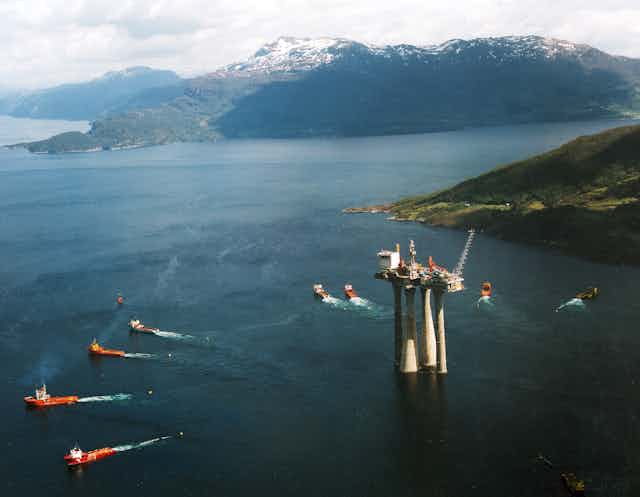In the midst of the debate around whether Australia is correctly taxing miners, Paul Cleary provides a well-researched and written account of Norway’s approach to the development of its oil resources since the 1960s in his book Trillion Dollar Baby.
Cleary ties together a number of threads that are surprisingly relevant for many of our current policy debates. The book focuses on the establishment of a regulatory and institutional framework to ensure that the owners of the natural resources - the country’s citizens, both current and future - benefit appropriately from them.
The unfolding of Norway’s story is very different from our own recent experience with the latest mining boom. For example, while Norway reduced the central government debt from 36% of GDP in 2003 to 21% of GDP in 2013, we increased our central government debt from 24% to 38% of GDP in the same period.
While the Australian economy has certainly benefited from the mineral boom, Cleary makes the point that at the end of it we “owe the world A$1 trillion”. He contrasts this against Norway, with a sovereign fund that “is on track to hit A$1 trillion in 2020”.

Norway’s success is attributed to three key elements. First, a tax regime that includes a super profit tax, which has generated substantial revenue for the government.
Second, the design of a sovereign fund that began to accumulate once the government started to generate surpluses and that was invested exclusively outside Norway. Because of this, it increased in value as the local currency appreciated as a result of the increase in oil prices. Also, it to some extent dampened the appreciation of the currency and the associated impact on the non-oil sectors of the economy.
Finally, withdrawals from the fund were limited to a fixed percentage, which has to some extent been about the average real return from the fund.
There are also other subplots in the book, weaved into the overall narrative, that serve as lessons for Australia. For example, Cleary stresses the importance of the link between universities and industry: “unlike the UK, Norway shifted almost overnight from geology courses about rocks and minerals to petroleum geology and engineering”. But he does not explain what made Norwegian universities more responsive than their United Kingdom counterparts.
Despite Australia’s own mining boom, I am only aware of less than a handful of courses in Australia that are dedicated explicitly to the economics of mining rather than more general courses on natural resources economics.
Other threads include the key role played by the public sector bureaucracy “that had a long tradition of dealing with powerful foreign interests”. A part of this was the importance of making the regulatory and taxation regimes robust enough to “drive a stake through the heart of tax minimisation by multinational companies”.
Another thread relates to the tension between profits and safety. Prior to the introduction of effective regulation in Norway, companies disregarded safety concerns at the expense of human life. Cleary describes a particular callous episode where, ten days after the Kielland platform disaster of March 1980 where 123 workers died, Phillips sought and secured approval from the regulator to release a large quantity of drilling mud into the sea, making the task of recovering bodies even more challenging.
Perhaps the side story that I enjoyed the most was that of Farouk Al-Kasim, an Iraqi Petroleum geologist who migrated to Norway in 1968 and became an employee of the Norwegian Petroleum Directorate. As a migrant myself who strives to make a positive contribution to my adopted country, I can only dream of one day being as successful as Al-Kasim who added “a conservative A$50 billion in revenue to the coffers of the Norwegian treasury.”

Cleary also highlights some potential pitfalls in Norway’s success story. For example, Cleary discusses Norway’s attitude towards pursuing oil exploration in the Artic Region and its impact on the environment.
He also argues that the rise of political populism, including anti-immigration and a narrow type of nationalism, has increased the pressure to ease some of the constraints that have worked to ensure the success of Norway’s sovereign fund. In particular, while populism can lead to the relaxation of the limits on fund withdrawals (in order to increase government coffers), a narrow nationalistic view may work to ease the requirement to invest outside Norway and instead use the fund to support investment in domestic infrastructure.
In principle, domestic investment may yield higher returns than investing abroad, but it can also lead to pork barrelling, among other problems. In addition to this, requiring investments to be exclusively outside Norway has worked well in hedging exchange rate risk.
Ultimately, it will not be possible for Norway to avoid the challenges that arise from the combination of higher government expenditure, resulting from the increasing demands of the welfare state and of the ageing population, and the fact that oil and gas production (and revenues) have already peaked. However, Norway’s successful sovereign fund will go a long away towards meeting these challenges.
All in all, Trillion Dollar Baby makes a very good read, and arguably a must read for natural resources policy wonks. There is much to consider even if you don’t agree with the lessons that Cleary outlines in the book’s afterword.
We should revisit Australia’s mining tax to prepare for future commodities price rises that will follow the economic growth of other large developing economies such as India. We should also reconsider the wisdom of setting up a sovereign fund that invests exclusively in foreign assets.
My own take from the book is that although it will be challenging in the current policy environment to develop a sound natural resource policies, we should not give up on a tax on profits to replace output taxes such as royalties. Australians should also continue to have the conversations and lay the ground work to ensure that we are ready to implement better policies when the opportunity arises.

